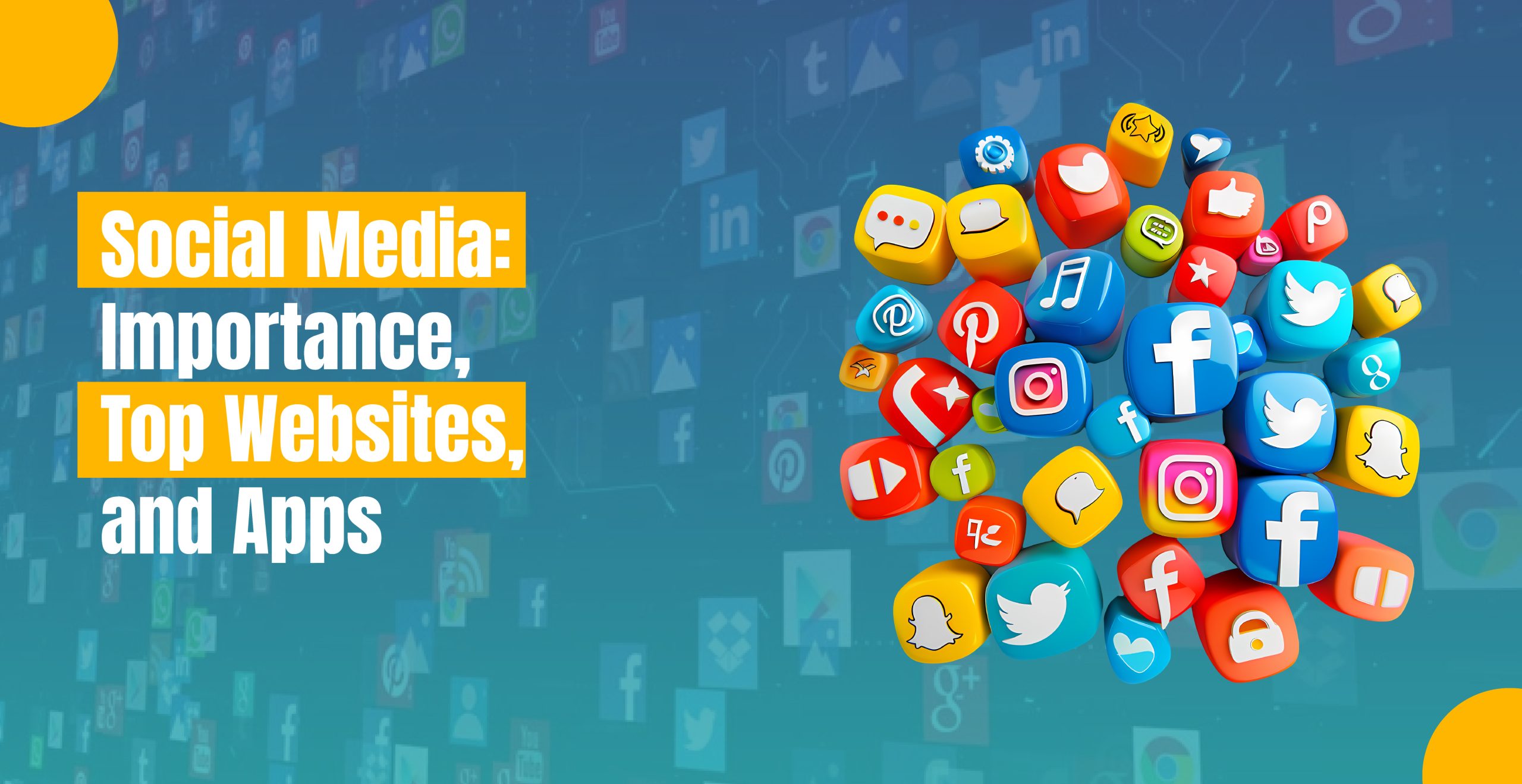Social media has become an essential tool for users to connect, share information, and engage in virtual communities across the globe. Through mobile apps and platforms, people can easily share content, whether it’s photos, updates, or videos, making it a vital part of socializing online. Whether you’re posting user-created content or interacting with others, social media offers instant access to conversations and ideas, allowing for real-time communication. As a marketer, it has significantly impacted how businesses grow, giving them direct access to their audience, allowing them to target specific groups and expand their reach.
The importance of social media goes beyond just connecting people; it also plays a huge role in brand marketing and visibility. With top websites and apps like Facebook, Instagram, and Twitter, you can increase your online presence, boost engagement, and visibility while building a personal or professional brand. In my experience, social media is a powerful tool for creating engagement and fostering collaboration in a way that traditional forms of communication can’t match. By leveraging apps, websites, and socializing, you can tap into an ocean of growth potential while staying connected with the global community.
Words not used: platforms, communication, social, interaction, feedback, conversation, response, collaboration, participation, creativity, tools, online, exposure, outreach, involvement, notifications, feedback, sharing, apps, creativity, platforms, media, marketers.
What Is Social Media?
Social media is a dynamic form of digital communication that connects users across the globe, allowing them to share information through various mediums such as text, photos, videos, and more. With over five billion global users in 2024, it has become a space where millions of people engage in socializing, sharing content, and forming virtual communities. Popular platforms like Facebook, Instagram, and TikTok, as well as messaging and chat apps, are key tools that help people interact, create content, and stay updated on the latest news and trends.
From a business perspective, social media offers unmatched opportunities to increase visibility, drive engagement, and build lasting relationships with audiences. Communities such as Reddit and Discord provide unique spaces for like-minded individuals to collaborate, share experiences, and offer feedback. This ever-expanding landscape provides valuable insights into user behavior and trends, making it an essential component of modern marketing and branding strategies.
Key Takeaways
Social media comprises a variety of websites, apps, and platforms where users can share information and ideas with virtual communities using text, photos, videos, and more. With more than five billion global users, it serves both personal and professional purposes, allowing people to connect and engage in meaningful ways. Social media has significantly contributed to community building, enabling individuals to stay informed and share important information in real-time.
However, there are concerns about its impact on mental health, especially for adolescents, with critics arguing that it contributes to increased misinformation, and facilitates negative activities like child sexual abuse. On the other hand, platforms like Facebook, YouTube, WhatsApp, Instagram, and TikTok are among the largest and most popular platforms, widely used for both entertainment and business. Social media continues to evolve, raising both opportunities and challenges in the digital age.
Origins and Evolution of Social Media
The origins of social media can be traced back to early platforms like MySpace and LiveJournal, designed to help users connect with friends and family. MySpace, for example, allowed users to create personal profiles and share information about themselves, becoming the first platform to reach one million active monthly users in 2004. Similarly, LiveJournal gained popularity, allowing individuals to share journal-like entries within either public or private networks, eventually reaching over 2.5 million active accounts by 2005.
As social media grew in the 2000s and early 2010s, platforms like Facebook and X (formerly Twitter) became dominant. Facebook allowed users to create profiles, post updates, and interact through comments, becoming popular among both younger and older audiences. In 2006, X launched its feed feature, which aggregated posts from accounts users followed, while Facebook introduced its own News Feed. This feature revolutionized how content was shared and interacted with, becoming a standard for most social media platforms. As users began posting links to external sites, news, product updates, and current events, engagement grew, allowing for interactions like liking, sharing, and commenting.
As social media evolved, platforms began adding business-specific profile pages and the option to purchase targeted ads, allowing businesses to promote their products directly to users. This shift made social media more business-friendly and significantly boosted revenue for the platforms. Users started spending more time scrolling through feeds, engaging with daily news and commentary about current events. By 2024, over half (54%) of adults in the U.S. reported getting their news from social media “sometimes” or “often,” with only 28% saying they “never” do. On a global scale, just 22% of consumers get their news from news websites or apps, with younger audiences being the least likely to do so.
How Social Media Is Used Today
Today, social media has diversified into various types of platforms that serve different purposes and users. These platforms can be broadly categorized into different types, each offering unique features. Social networks like Facebook and NextDoor allow users to connect and socialize with friends and local communities. Microblogging sites such as X, BlueSky, Mastodon, and Threads allow for quick posts and updates, fostering engagement in real-time. On the other hand, long-form blogging platforms like Substack and Ghost provide space for in-depth articles and personal content creation.
For professional networking, platforms like LinkedIn, Behance, and ResearchGate enable users to build career connections and explore job opportunities. Meanwhile, video and photo sharing sites like Instagram, TikTok, YouTube, and Snapchat focus on visual content, allowing users to share moments through videos and images. Visual curation and search platforms such as Pinterest, Houzz, and DeviantArt let users discover and share ideas related to art, design, and home decor. Messaging apps like WhatsApp, Signal, WeChat, and Marco Polo focus on communication, enabling users to interact in private or group chats. Finally, community forums such as Reddit, Discord, and Clubhouse offer spaces for discussion, debates, and building niche communities.
Each platform serves a different purpose, whether it’s for socializing, professional networking, or sharing content related to hobbies or political views. The diversity in platforms ensures that users can find spaces that match their interests and needs. Many social media users are now leveraging platforms for professional purposes. For example, actors and writers use social media to connect with fans and promote their work. Politicians engage with constituents and voters to share updates, policies, and opinions. Nonprofit organizations utilize these platforms to raise awareness for charitable causes, share success stories, and even collect donations. Furthermore, government agencies rely on social media as a communication tool during emergencies, helping keep the public informed in real-time.
Posting content on social media can now be a full-time job, separate from any outside work it may be promoting. This trend has given rise to influencers and content creators, who produce user-generated content for sponsored promotions or follower support. In fact, one in five social media users consider themselves professional content creators. These individuals not only share their personal lives but also monetize their influence through collaborations and partnerships.For businesses, social media serves as a crucial tool for marketing. Companies use these platforms to track consumer trends, interact with customers, and gather valuable data. Targeted advertising is an effective way to reach specific demographics, and many companies collaborate with influencers, paying them to promote products directly to their followers. Remarkably, 94.7% of internet users between the ages of 16 and 64 visited at least one social networking site in the past month, emphasizing the global reach and importance of social media for both personal and professional purposes.
Advantages Explained
Social media offers several advantages, starting with connectivity. These platforms allow users to access global information and connect with friends and family, even from a distance. They provide opportunities to discover niche communities centered around shared interests, such as neighborhood forums or job searching groups. This connectivity fosters a broader, more diverse network of interactions.
Another key benefit is the ability to build community. Social media is strongly correlated with having a more diverse personal network, especially in emerging economies. It encourages interactions between individuals from different backgrounds, including income, political party, religion, and ethnicity. Users are more likely to engage with others who may not share the same views or experiences, creating a richer and more inclusive environment.
For businesses, social media provides affordable advertising options. Small businesses and creators can reach a large audience with relatively low costs through targeted ads and influencer marketing. With more than 200 million small businesses using Facebook, social media has become an essential tool for growth. In fact, online advertising, including social media and search advertising, accounted for 59% of global ad spending in 2024, with projections to increase to 61% by 2026.
Disadvantages Explained
While social media offers numerous benefits, it also comes with significant disadvantages. One of the major concerns is disinformation/misinformation. The ease of sharing links and posts can lead to the rapid spread of false information. For example, misinformation about Hurricane Helene in 2024 hindered recovery efforts in the southern U.S. and caused harm to local communities. This shows how social media can exacerbate disasters by spreading misleading content.
Another concern is sleep disruption. Social media use has been linked to poor-quality sleep, particularly among teens and young adults. Research shows that extended social media use can lead to sleep deprivation, which is associated with various health issues such as heart disease, high blood pressure, diabetes, obesity, and depression. The constant engagement with feeds and notifications can make it difficult to disconnect, leading to disrupted sleep patterns.
Furthermore, the mental health impact of social media is a growing concern. Studies have found a direct correlation between increased social media use and higher rates of depression, especially among teens. Other issues related to mental health include bullying, peer pressure, the spread of rumors, and the creation of unrealistic expectations based on the highly curated lives of others on these platforms. The pressure to compare oneself to others can significantly affect an individual’s self-esteem.
Lastly, child sexual abuse is a severe disadvantage associated with social media. In 2022, research revealed that over one in six U.S. children experienced sexual abuse online, with studies in other countries reporting even higher rates. Social media can unfortunately provide a platform for abuse and exploitation, including grooming, stalking, sharing explicit materials, and revenge pornography. The lack of strict regulations and the anonymity provided by these platforms create an environment where such crimes can occur.


